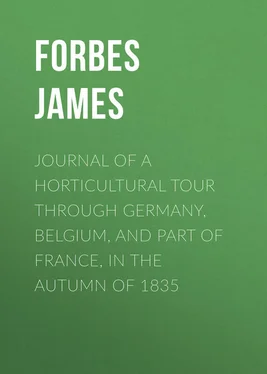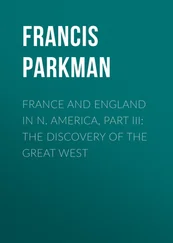James Forbes - Journal of a Horticultural Tour through Germany, Belgium, and part of France, in the Autumn of 1835
Здесь есть возможность читать онлайн «James Forbes - Journal of a Horticultural Tour through Germany, Belgium, and part of France, in the Autumn of 1835» — ознакомительный отрывок электронной книги совершенно бесплатно, а после прочтения отрывка купить полную версию. В некоторых случаях можно слушать аудио, скачать через торрент в формате fb2 и присутствует краткое содержание. Жанр: foreign_home, Сад и огород, foreign_antique, foreign_prose, на английском языке. Описание произведения, (предисловие) а так же отзывы посетителей доступны на портале библиотеки ЛибКат.
- Название:Journal of a Horticultural Tour through Germany, Belgium, and part of France, in the Autumn of 1835
- Автор:
- Жанр:
- Год:неизвестен
- ISBN:нет данных
- Рейтинг книги:3 / 5. Голосов: 1
-
Избранное:Добавить в избранное
- Отзывы:
-
Ваша оценка:
- 60
- 1
- 2
- 3
- 4
- 5
Journal of a Horticultural Tour through Germany, Belgium, and part of France, in the Autumn of 1835: краткое содержание, описание и аннотация
Предлагаем к чтению аннотацию, описание, краткое содержание или предисловие (зависит от того, что написал сам автор книги «Journal of a Horticultural Tour through Germany, Belgium, and part of France, in the Autumn of 1835»). Если вы не нашли необходимую информацию о книге — напишите в комментариях, мы постараемся отыскать её.
Journal of a Horticultural Tour through Germany, Belgium, and part of France, in the Autumn of 1835 — читать онлайн ознакомительный отрывок
Ниже представлен текст книги, разбитый по страницам. Система сохранения места последней прочитанной страницы, позволяет с удобством читать онлайн бесплатно книгу «Journal of a Horticultural Tour through Germany, Belgium, and part of France, in the Autumn of 1835», без необходимости каждый раз заново искать на чём Вы остановились. Поставьте закладку, и сможете в любой момент перейти на страницу, на которой закончили чтение.
Интервал:
Закладка:
August 28th. Went at six o'clock in the morning to see the fruit and vegetable market, but was rather disappointed in observing so very inferior a supply in comparison with what is to be seen in Covent Garden Market. In fact for some time I thought that I had gone to the wrong place, as the market is held every alternate day in two different parts of the town; but on enquiry I found it was seldom better supplied. Large quantities of grapes grown out of doors, or on trellis, were in the market; also a pretty good supply of peaches, but these were of a small size. I only observed one solitary pine apple, about one pound weight. The mode of preserving the fish, which were also brought to the market where the fruit and vegetables were exposed for sale, was new to me. They are kept alive in water in oval shaped wooden tubs or vessels, and each sort is kept separate. Large quantities of game, poultry, butcher's meat, as well as cart-loads of hay and straw, are found abundantly in the market.
After making a tour through the principal parts of the town, and getting my passport signed by the police and English ambassador, I made a second visit to Mr. Otto, and also then called on Dr. Kloytch, to whom I had a letter of introduction from Sir W. Hooker. Dr. Kloytch has the charge of the Royal Herbarium, which is situated opposite and nearly adjoining the Botanic Gardens, containing several apartments for dried specimens of all the plants that flower in the Royal Botanic Gardens, which are gathered and preserved as they appear in flower. Attached to the Royal Herbarium house is a piece of pleasure ground, one side of which is enclosed by a good brick wall that has projecting piers, betwixt which grape vines are trained, and confined to the spaces of about twelve feet between the projecting piers; each sort is thus prevented from intermixing with another; a wooden pailing enclosing another part of this garden is likewise adapted to the same purpose. Dr. Kloytch was once a pupil of Sir W. Hooker's at Glasgow, and is considered an eminent botanist, he has certainly formed a very natural arrangement of the different species in the genus Ericæ , arranged according to the form and structure of the flower. He shewed me several native specimens of this genus that I have not yet seen in England, but seeds of which I hope to receive from him before long. I was much gratified by the excellent method he described to me, in preserving the specimens of Fungi , which appears to be the most effectual mode of drying these plants that I have yet seen. After looking over various specimens in the Herbarium, Dr. Kloytch accompanied me to the Botanic Gardens, where I again saw Mr. Otto, and was enabled to see more minutely the extent of this noble collection of plants. It is proper to observe that the space of ground allotted for this garden, is not sufficiently large for such an extensive collection of plants. Many of the oaks and several other fine trees are too much crowded, and not seen to advantage. After examining all that I wished to see here, Mr. Otto, Dr. Kloytch, and Mr. Brackenridge, accompanied me into Berlin, where we passed through another fine part of the " Thiergarten ," and being joined by Mr. Cuming, the celebrated Zoologist, we spent a very pleasing evening in the discussion of botanical pursuits, and the cultivation and beauty of the Cacteæ in the Berlin Gardens.
August 29th. Left Berlin at seven o'clock in the morning for Potsdam, where I arrived at eleven o'clock in the forenoon, a distance of eighteen English miles. Every stranger must be forcibly struck with the scenery as he approaches Potsdam, particularly in passing Prince Charles's villa and grounds, with the view of the handsome bridge lately erected across the river Havel, at this side of the town expanding itself to a very capacious sheet of water. On my arrival at Potsdam I proceeded to the Royal Gardens at Sans-souci , which are situated about one English mile distant. Having a letter of introduction from M. Otto to M. Linne, the principal director, I was disappointed in not finding him at home. Free access was afforded to the various departments, and I then made the best use of my time in examining the different gardens attached to this residence, which required considerable diligence to get through a portion of the departments. I first inspected the kitchen garden, which is very extensive, and contains several ranges of low houses, and pits, for the forcing of cherries, plums, and apricots, with a good collection of standard fruit trees, as well as the walls being well stocked. The length and breadth of the principal range of houses in this garden, is 255 feet long, and about 9 feet in width; the upright sashes are eight feet high, placed in a slanting position; the roof-lights were about six feet long, but these lights were at this time all removed from the house, the trees being planted as standards in the interior border; the sashes are removed as soon as the fruit is gathered, in order to expose the trees to the full effect of the atmosphere. In another garden at a short distance from this vegetable one, there are numerous other ranges of hothouses for the forcing of fruits, which are in great request for the royal table. The structures here used for this purpose are about six feet high in front, and about ten feet in width; the length of the roof sashes were from nine to ten feet. In these houses the flues are placed at the back, running parallel to the backwall. Some of the houses are heated by hot-water pipes, rather of a novel construction, and I much fear not calculated to give any great command of heat; they consist of two round copper pipes, about two inches only in diameter, which run parallel along the front of the house about two feet apart from each other. The peach trees are planted inside the house, within one foot of the front wall, and are trained perpendicular to the trellis, to the height of six feet, being as high as the upright glass. A rider is then carried in general, close under the roof lights, trained to a lath trellis which is nailed to the underside of the rafter.
As soon as the frosty nights are over, the houses are generally stripped of the sashes, and the trees and fruit left fully exposed to the sun and weather, while the fruit is maturing; but such fruits as are wanted at an early period, are of course not thus exposed. I here observed various trees of plum, cherry, and apricot, thus treated, a more congenial mode of treatment, than by having recourse to pots or tubs, as is in general practised in this country, especially where there can be houses spared for this purpose, as the trees will get established in the ground, and be enabled to produce a more abundant crop and larger fruit than if their roots were confined to a small space for nourishment. I also saw here a great quantity of very fine melons, all trained over moss, and at this season these also were exposed to the weather. The appearance of the fine terraces in front of Sans-souci Palace, gave me more gratification than anything of the kind that I had previously seen. This palace, originally erected by Frederic the Great , is now a favourite summer residence of the Crown Prince. It is situated so as to command a most beautiful view of the surrounding country, with six tier of terraces in front of it, each terrace falling about twelve feet under another towards the south from the palace. Along the top are flower borders and broad gravel walks, with a row of very fine orange trees placed along the edge of the gravel walk on each of the terraces, which give them a magnificent appearance. Against these walls are trained principally grape vines, provided with a frame in front for covering them with glass; peaches and apricots are likewise here grown.
In the centre of each terrace is a noble flight of steps thirty-six feet wide at the bottom, but at the top the width is only fifteen feet; containing in each from twenty-five to twenty-seven steps. The view of these from the avenue or road by M. Lennie's house, is really grand: the different flights of steps from this point of view appear to form one connected tier leading to the palace, which, with its magnificent orange trees and groups of sculpture, strike the eye of every stranger with admiration. I here congratulated myself on being alone, and left to examine and take the dimensions of the various objects, without being hurried. At a short distance from the lower terrace is an oval basin of water, surrounded by a grass lawn and a gravel walk, or rather carriage drive; and on the exterior side of the circular sweep of the gravel, are placed twelve large statues. This basin was originally intended for a fountain; the reservoir for supplying it was formed by Frederic the Great on an eminence on the north side of Sans-Souci palace, where it must be several hundred feet above the level of the basin of water where the fountain was intended to be placed. The effect from the palace windows and from several other points of view, if it had been completed, would have been very magnificent when the water was playing. At a short distance from the palace is another large building, which was occupied by a part of the establishment; in front is a large piece of pleasure ground, in which are placed also a number of very fine orange trees; one of them, pointed out to me, is named after Frederic the Great , his majesty being a great admirer of these trees, insomuch, that during the war he took possession of all the best that came in his way, and sent them to his royal gardens at Potsdam. The head of this tree, named Frederic the Great, was equal to one of our ordinary sized Portugal laurels, its branches extend over seventeen yards of ground in diameter. I should imagine there must be fully 400 trees grown in this establishment, all of large dimensions. The soil in which they are grown consists of a black sandy loam, well incorporated with cow-dung and rotten leaf mould, with a mixture of bone dust, in some cases horn shavings. The houses for the protection of the orange trees in the winter season, are simply a long range or ranges of red tiled roofed buildings, with merely upright lights in the front or south side, which are provided with wooden shutters that are closed during frosty weather. The flues run along in the floor of the house, and are not calculated to give out much heat, but the roof and back wall being opaque, and the front furnished with shutters, little heat is required for preserving the trees from the frost. They are generally turned out of doors in the month of May, and not taken in again until October. Arranged along with the orange trees I observed a very fine specimen of the Nerium Oleander , covered with blossom, also several fine plants of the pomegranate, covered with flowers. The figs were also in prolific state against a wall and growing in light sandy loam. At the opposite end of the palace is situated the picture gallery, which opens into another garden department, with hornbeam hedges, and numerous box edging scrolls; but this piece of ground is evidently not much attended to: the walks, flowers, borders, are not in good order. The collection of paintings, however, in the gallery will infinitely repay the visitor for the disappointment he may experience in the badly kept garden. This gallery is two hundred and fifty-two feet long, and thirty-six feet wide; the dome and cove ceiling are richly gilt, the floor and walls inlaid with marble. The paintings are very numerous, and in beautiful preservation. Those taken from this gallery by Buonaparte and again replaced in the spot they originally occupied, are particularly pointed out to the visitor. I observed on each side of the door, as we entered this gallery, two very fine marble statues, one of Diana , the other of Louis XVI. A straight avenue or drive leading from the Potsdam road, in a direct line by the front of the terraces at Sans-souci, to the new palace, is of considerable length. At the extremity of this avenue is the magnificent palace built by Frederic , after the completion of the wars in which he was engaged. It is said to have been erected with the English subsidy; however this may be, it is undoubtedly a very magnificent building.
Читать дальшеИнтервал:
Закладка:
Похожие книги на «Journal of a Horticultural Tour through Germany, Belgium, and part of France, in the Autumn of 1835»
Представляем Вашему вниманию похожие книги на «Journal of a Horticultural Tour through Germany, Belgium, and part of France, in the Autumn of 1835» списком для выбора. Мы отобрали схожую по названию и смыслу литературу в надежде предоставить читателям больше вариантов отыскать новые, интересные, ещё непрочитанные произведения.
Обсуждение, отзывы о книге «Journal of a Horticultural Tour through Germany, Belgium, and part of France, in the Autumn of 1835» и просто собственные мнения читателей. Оставьте ваши комментарии, напишите, что Вы думаете о произведении, его смысле или главных героях. Укажите что конкретно понравилось, а что нет, и почему Вы так считаете.












